Analysis of Issues in G-Train's Information System
VerifiedAdded on 2022/12/19
|10
|4376
|85
AI Summary
This report provides a detailed analysis of the current issues in the train services of G-Train and recommends a solution for the underlying issues. It focuses on the problematic areas in the present human activity system and proposes a new information system with a mobile application for ticket booking.
Contribute Materials
Your contribution can guide someone’s learning journey. Share your
documents today.
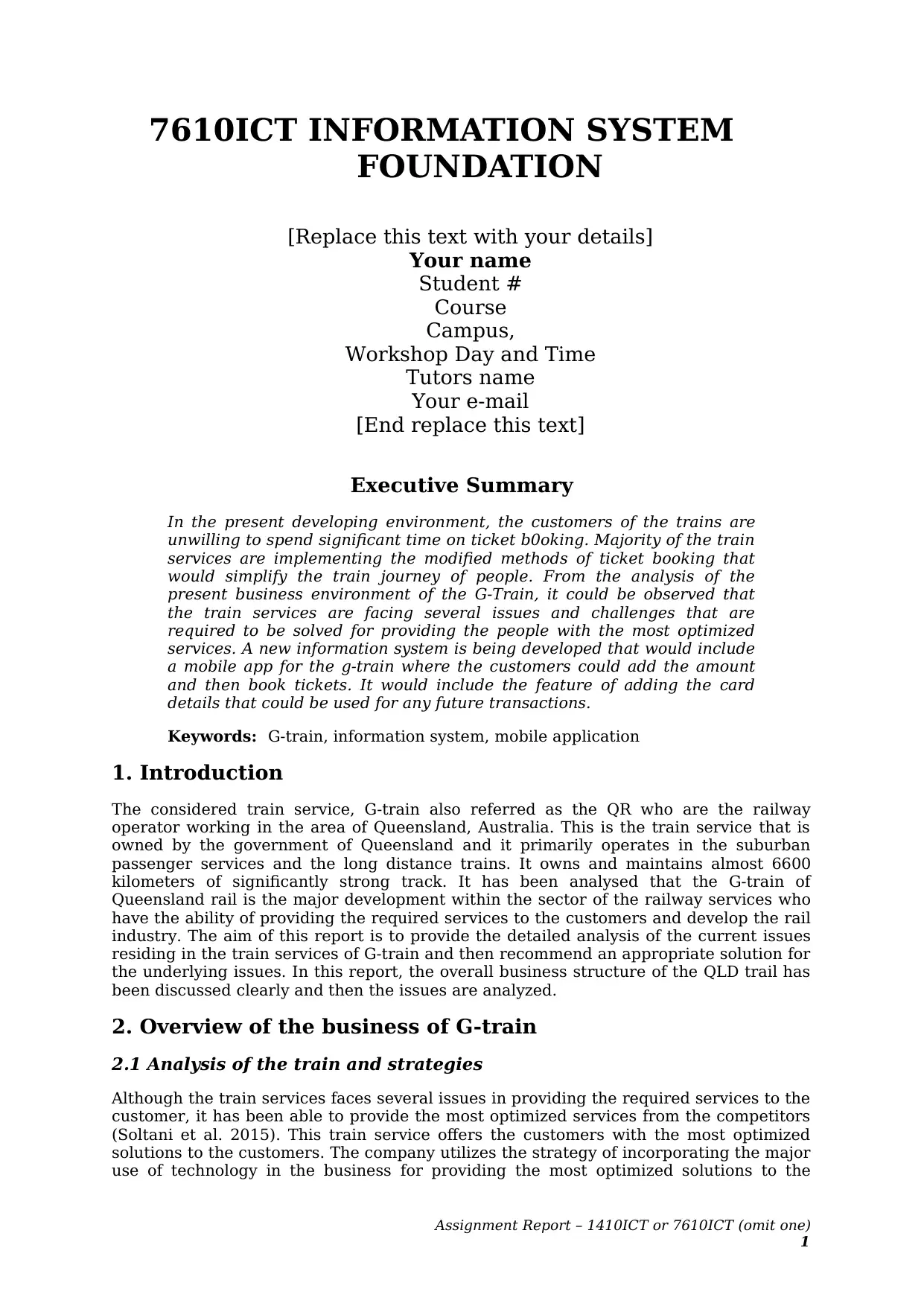
7610ICT INFORMATION SYSTEM
FOUNDATION
[Replace this text with your details]
Your name
Student #
Course
Campus,
Workshop Day and Time
Tutors name
Your e-mail
[End replace this text]
Executive Summary
In the present developing environment, the customers of the trains are
unwilling to spend significant time on ticket b0oking. Majority of the train
services are implementing the modified methods of ticket booking that
would simplify the train journey of people. From the analysis of the
present business environment of the G-Train, it could be observed that
the train services are facing several issues and challenges that are
required to be solved for providing the people with the most optimized
services. A new information system is being developed that would include
a mobile app for the g-train where the customers could add the amount
and then book tickets. It would include the feature of adding the card
details that could be used for any future transactions.
Keywords: G-train, information system, mobile application
1. Introduction
The considered train service, G-train also referred as the QR who are the railway
operator working in the area of Queensland, Australia. This is the train service that is
owned by the government of Queensland and it primarily operates in the suburban
passenger services and the long distance trains. It owns and maintains almost 6600
kilometers of significantly strong track. It has been analysed that the G-train of
Queensland rail is the major development within the sector of the railway services who
have the ability of providing the required services to the customers and develop the rail
industry. The aim of this report is to provide the detailed analysis of the current issues
residing in the train services of G-train and then recommend an appropriate solution for
the underlying issues. In this report, the overall business structure of the QLD trail has
been discussed clearly and then the issues are analyzed.
2. Overview of the business of G-train
2.1 Analysis of the train and strategies
Although the train services faces several issues in providing the required services to the
customer, it has been able to provide the most optimized services from the competitors
(Soltani et al. 2015). This train service offers the customers with the most optimized
solutions to the customers. The company utilizes the strategy of incorporating the major
use of technology in the business for providing the most optimized solutions to the
Assignment Report – 1410ICT or 7610ICT (omit one)
1
FOUNDATION
[Replace this text with your details]
Your name
Student #
Course
Campus,
Workshop Day and Time
Tutors name
Your e-mail
[End replace this text]
Executive Summary
In the present developing environment, the customers of the trains are
unwilling to spend significant time on ticket b0oking. Majority of the train
services are implementing the modified methods of ticket booking that
would simplify the train journey of people. From the analysis of the
present business environment of the G-Train, it could be observed that
the train services are facing several issues and challenges that are
required to be solved for providing the people with the most optimized
services. A new information system is being developed that would include
a mobile app for the g-train where the customers could add the amount
and then book tickets. It would include the feature of adding the card
details that could be used for any future transactions.
Keywords: G-train, information system, mobile application
1. Introduction
The considered train service, G-train also referred as the QR who are the railway
operator working in the area of Queensland, Australia. This is the train service that is
owned by the government of Queensland and it primarily operates in the suburban
passenger services and the long distance trains. It owns and maintains almost 6600
kilometers of significantly strong track. It has been analysed that the G-train of
Queensland rail is the major development within the sector of the railway services who
have the ability of providing the required services to the customers and develop the rail
industry. The aim of this report is to provide the detailed analysis of the current issues
residing in the train services of G-train and then recommend an appropriate solution for
the underlying issues. In this report, the overall business structure of the QLD trail has
been discussed clearly and then the issues are analyzed.
2. Overview of the business of G-train
2.1 Analysis of the train and strategies
Although the train services faces several issues in providing the required services to the
customer, it has been able to provide the most optimized services from the competitors
(Soltani et al. 2015). This train service offers the customers with the most optimized
solutions to the customers. The company utilizes the strategy of incorporating the major
use of technology in the business for providing the most optimized solutions to the
Assignment Report – 1410ICT or 7610ICT (omit one)
1
Secure Best Marks with AI Grader
Need help grading? Try our AI Grader for instant feedback on your assignments.
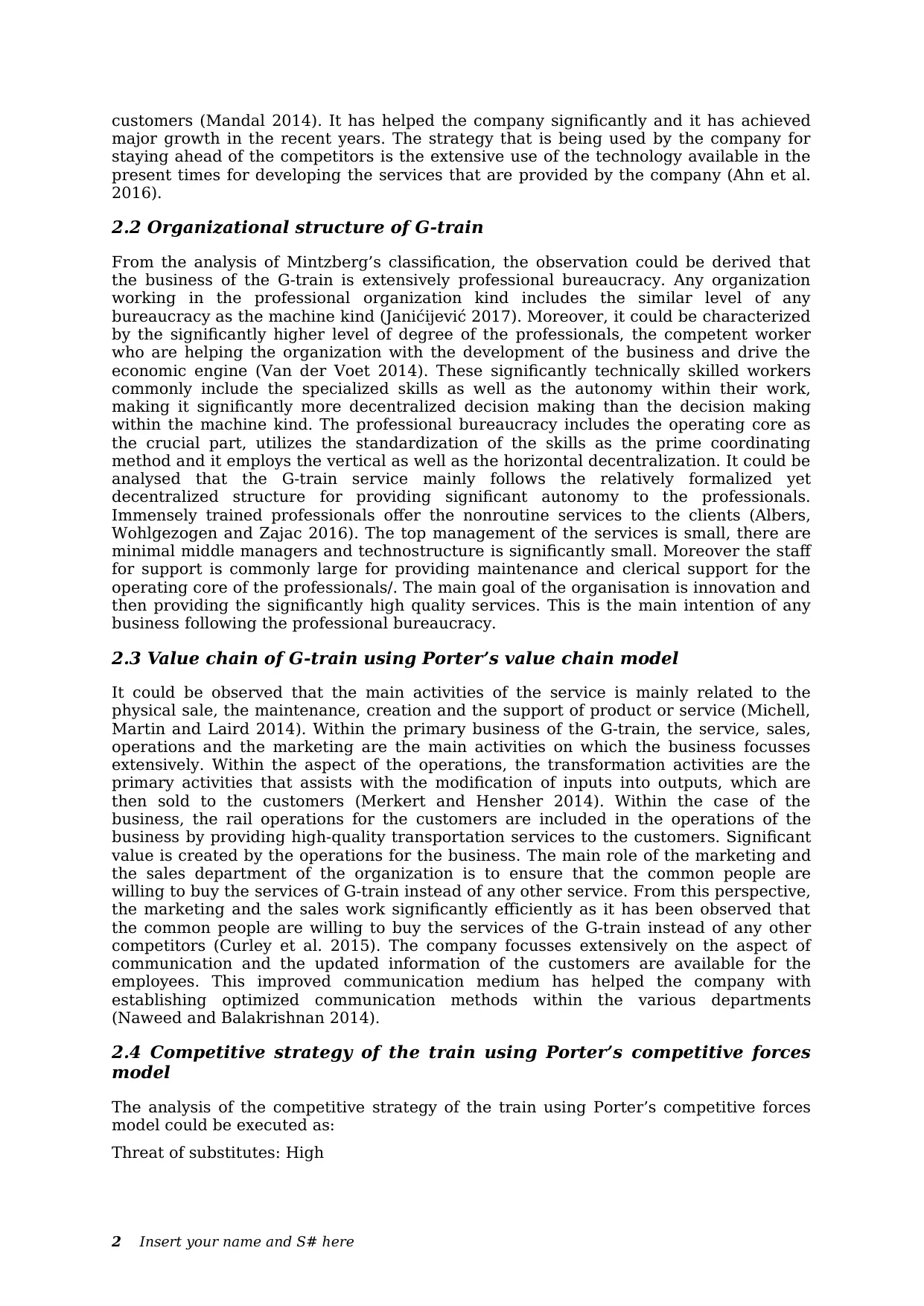
customers (Mandal 2014). It has helped the company significantly and it has achieved
major growth in the recent years. The strategy that is being used by the company for
staying ahead of the competitors is the extensive use of the technology available in the
present times for developing the services that are provided by the company (Ahn et al.
2016).
2.2 Organizational structure of G-train
From the analysis of Mintzberg’s classification, the observation could be derived that
the business of the G-train is extensively professional bureaucracy. Any organization
working in the professional organization kind includes the similar level of any
bureaucracy as the machine kind (Janićijević 2017). Moreover, it could be characterized
by the significantly higher level of degree of the professionals, the competent worker
who are helping the organization with the development of the business and drive the
economic engine (Van der Voet 2014). These significantly technically skilled workers
commonly include the specialized skills as well as the autonomy within their work,
making it significantly more decentralized decision making than the decision making
within the machine kind. The professional bureaucracy includes the operating core as
the crucial part, utilizes the standardization of the skills as the prime coordinating
method and it employs the vertical as well as the horizontal decentralization. It could be
analysed that the G-train service mainly follows the relatively formalized yet
decentralized structure for providing significant autonomy to the professionals.
Immensely trained professionals offer the nonroutine services to the clients (Albers,
Wohlgezogen and Zajac 2016). The top management of the services is small, there are
minimal middle managers and technostructure is significantly small. Moreover the staff
for support is commonly large for providing maintenance and clerical support for the
operating core of the professionals/. The main goal of the organisation is innovation and
then providing the significantly high quality services. This is the main intention of any
business following the professional bureaucracy.
2.3 Value chain of G-train using Porter’s value chain model
It could be observed that the main activities of the service is mainly related to the
physical sale, the maintenance, creation and the support of product or service (Michell,
Martin and Laird 2014). Within the primary business of the G-train, the service, sales,
operations and the marketing are the main activities on which the business focusses
extensively. Within the aspect of the operations, the transformation activities are the
primary activities that assists with the modification of inputs into outputs, which are
then sold to the customers (Merkert and Hensher 2014). Within the case of the
business, the rail operations for the customers are included in the operations of the
business by providing high-quality transportation services to the customers. Significant
value is created by the operations for the business. The main role of the marketing and
the sales department of the organization is to ensure that the common people are
willing to buy the services of G-train instead of any other service. From this perspective,
the marketing and the sales work significantly efficiently as it has been observed that
the common people are willing to buy the services of the G-train instead of any other
competitors (Curley et al. 2015). The company focusses extensively on the aspect of
communication and the updated information of the customers are available for the
employees. This improved communication medium has helped the company with
establishing optimized communication methods within the various departments
(Naweed and Balakrishnan 2014).
2.4 Competitive strategy of the train using Porter’s competitive forces
model
The analysis of the competitive strategy of the train using Porter’s competitive forces
model could be executed as:
Threat of substitutes: High
2 Insert your name and S# here
major growth in the recent years. The strategy that is being used by the company for
staying ahead of the competitors is the extensive use of the technology available in the
present times for developing the services that are provided by the company (Ahn et al.
2016).
2.2 Organizational structure of G-train
From the analysis of Mintzberg’s classification, the observation could be derived that
the business of the G-train is extensively professional bureaucracy. Any organization
working in the professional organization kind includes the similar level of any
bureaucracy as the machine kind (Janićijević 2017). Moreover, it could be characterized
by the significantly higher level of degree of the professionals, the competent worker
who are helping the organization with the development of the business and drive the
economic engine (Van der Voet 2014). These significantly technically skilled workers
commonly include the specialized skills as well as the autonomy within their work,
making it significantly more decentralized decision making than the decision making
within the machine kind. The professional bureaucracy includes the operating core as
the crucial part, utilizes the standardization of the skills as the prime coordinating
method and it employs the vertical as well as the horizontal decentralization. It could be
analysed that the G-train service mainly follows the relatively formalized yet
decentralized structure for providing significant autonomy to the professionals.
Immensely trained professionals offer the nonroutine services to the clients (Albers,
Wohlgezogen and Zajac 2016). The top management of the services is small, there are
minimal middle managers and technostructure is significantly small. Moreover the staff
for support is commonly large for providing maintenance and clerical support for the
operating core of the professionals/. The main goal of the organisation is innovation and
then providing the significantly high quality services. This is the main intention of any
business following the professional bureaucracy.
2.3 Value chain of G-train using Porter’s value chain model
It could be observed that the main activities of the service is mainly related to the
physical sale, the maintenance, creation and the support of product or service (Michell,
Martin and Laird 2014). Within the primary business of the G-train, the service, sales,
operations and the marketing are the main activities on which the business focusses
extensively. Within the aspect of the operations, the transformation activities are the
primary activities that assists with the modification of inputs into outputs, which are
then sold to the customers (Merkert and Hensher 2014). Within the case of the
business, the rail operations for the customers are included in the operations of the
business by providing high-quality transportation services to the customers. Significant
value is created by the operations for the business. The main role of the marketing and
the sales department of the organization is to ensure that the common people are
willing to buy the services of G-train instead of any other service. From this perspective,
the marketing and the sales work significantly efficiently as it has been observed that
the common people are willing to buy the services of the G-train instead of any other
competitors (Curley et al. 2015). The company focusses extensively on the aspect of
communication and the updated information of the customers are available for the
employees. This improved communication medium has helped the company with
establishing optimized communication methods within the various departments
(Naweed and Balakrishnan 2014).
2.4 Competitive strategy of the train using Porter’s competitive forces
model
The analysis of the competitive strategy of the train using Porter’s competitive forces
model could be executed as:
Threat of substitutes: High
2 Insert your name and S# here
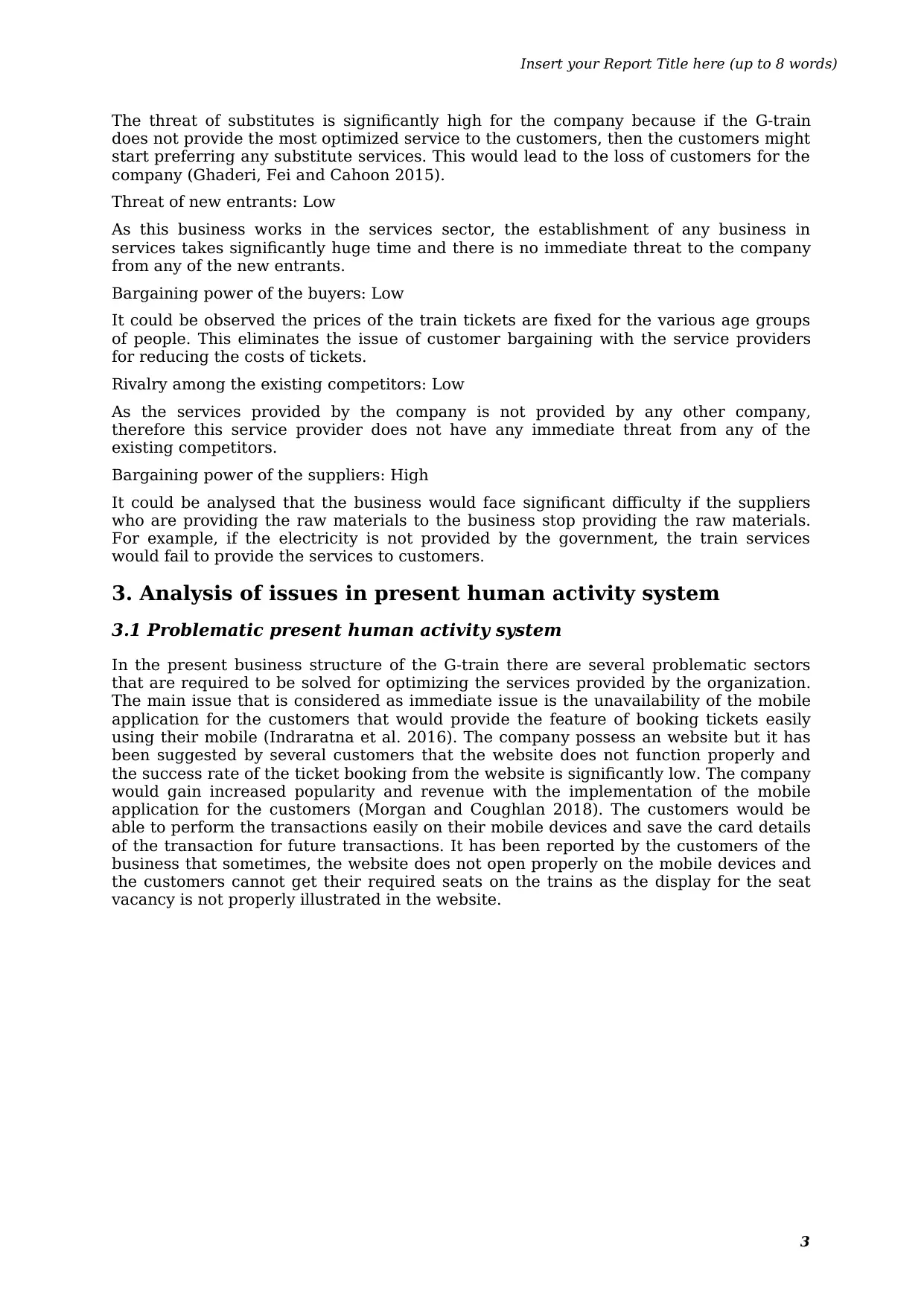
Insert your Report Title here (up to 8 words)
The threat of substitutes is significantly high for the company because if the G-train
does not provide the most optimized service to the customers, then the customers might
start preferring any substitute services. This would lead to the loss of customers for the
company (Ghaderi, Fei and Cahoon 2015).
Threat of new entrants: Low
As this business works in the services sector, the establishment of any business in
services takes significantly huge time and there is no immediate threat to the company
from any of the new entrants.
Bargaining power of the buyers: Low
It could be observed the prices of the train tickets are fixed for the various age groups
of people. This eliminates the issue of customer bargaining with the service providers
for reducing the costs of tickets.
Rivalry among the existing competitors: Low
As the services provided by the company is not provided by any other company,
therefore this service provider does not have any immediate threat from any of the
existing competitors.
Bargaining power of the suppliers: High
It could be analysed that the business would face significant difficulty if the suppliers
who are providing the raw materials to the business stop providing the raw materials.
For example, if the electricity is not provided by the government, the train services
would fail to provide the services to customers.
3. Analysis of issues in present human activity system
3.1 Problematic present human activity system
In the present business structure of the G-train there are several problematic sectors
that are required to be solved for optimizing the services provided by the organization.
The main issue that is considered as immediate issue is the unavailability of the mobile
application for the customers that would provide the feature of booking tickets easily
using their mobile (Indraratna et al. 2016). The company possess an website but it has
been suggested by several customers that the website does not function properly and
the success rate of the ticket booking from the website is significantly low. The company
would gain increased popularity and revenue with the implementation of the mobile
application for the customers (Morgan and Coughlan 2018). The customers would be
able to perform the transactions easily on their mobile devices and save the card details
of the transaction for future transactions. It has been reported by the customers of the
business that sometimes, the website does not open properly on the mobile devices and
the customers cannot get their required seats on the trains as the display for the seat
vacancy is not properly illustrated in the website.
3
The threat of substitutes is significantly high for the company because if the G-train
does not provide the most optimized service to the customers, then the customers might
start preferring any substitute services. This would lead to the loss of customers for the
company (Ghaderi, Fei and Cahoon 2015).
Threat of new entrants: Low
As this business works in the services sector, the establishment of any business in
services takes significantly huge time and there is no immediate threat to the company
from any of the new entrants.
Bargaining power of the buyers: Low
It could be observed the prices of the train tickets are fixed for the various age groups
of people. This eliminates the issue of customer bargaining with the service providers
for reducing the costs of tickets.
Rivalry among the existing competitors: Low
As the services provided by the company is not provided by any other company,
therefore this service provider does not have any immediate threat from any of the
existing competitors.
Bargaining power of the suppliers: High
It could be analysed that the business would face significant difficulty if the suppliers
who are providing the raw materials to the business stop providing the raw materials.
For example, if the electricity is not provided by the government, the train services
would fail to provide the services to customers.
3. Analysis of issues in present human activity system
3.1 Problematic present human activity system
In the present business structure of the G-train there are several problematic sectors
that are required to be solved for optimizing the services provided by the organization.
The main issue that is considered as immediate issue is the unavailability of the mobile
application for the customers that would provide the feature of booking tickets easily
using their mobile (Indraratna et al. 2016). The company possess an website but it has
been suggested by several customers that the website does not function properly and
the success rate of the ticket booking from the website is significantly low. The company
would gain increased popularity and revenue with the implementation of the mobile
application for the customers (Morgan and Coughlan 2018). The customers would be
able to perform the transactions easily on their mobile devices and save the card details
of the transaction for future transactions. It has been reported by the customers of the
business that sometimes, the website does not open properly on the mobile devices and
the customers cannot get their required seats on the trains as the display for the seat
vacancy is not properly illustrated in the website.
3
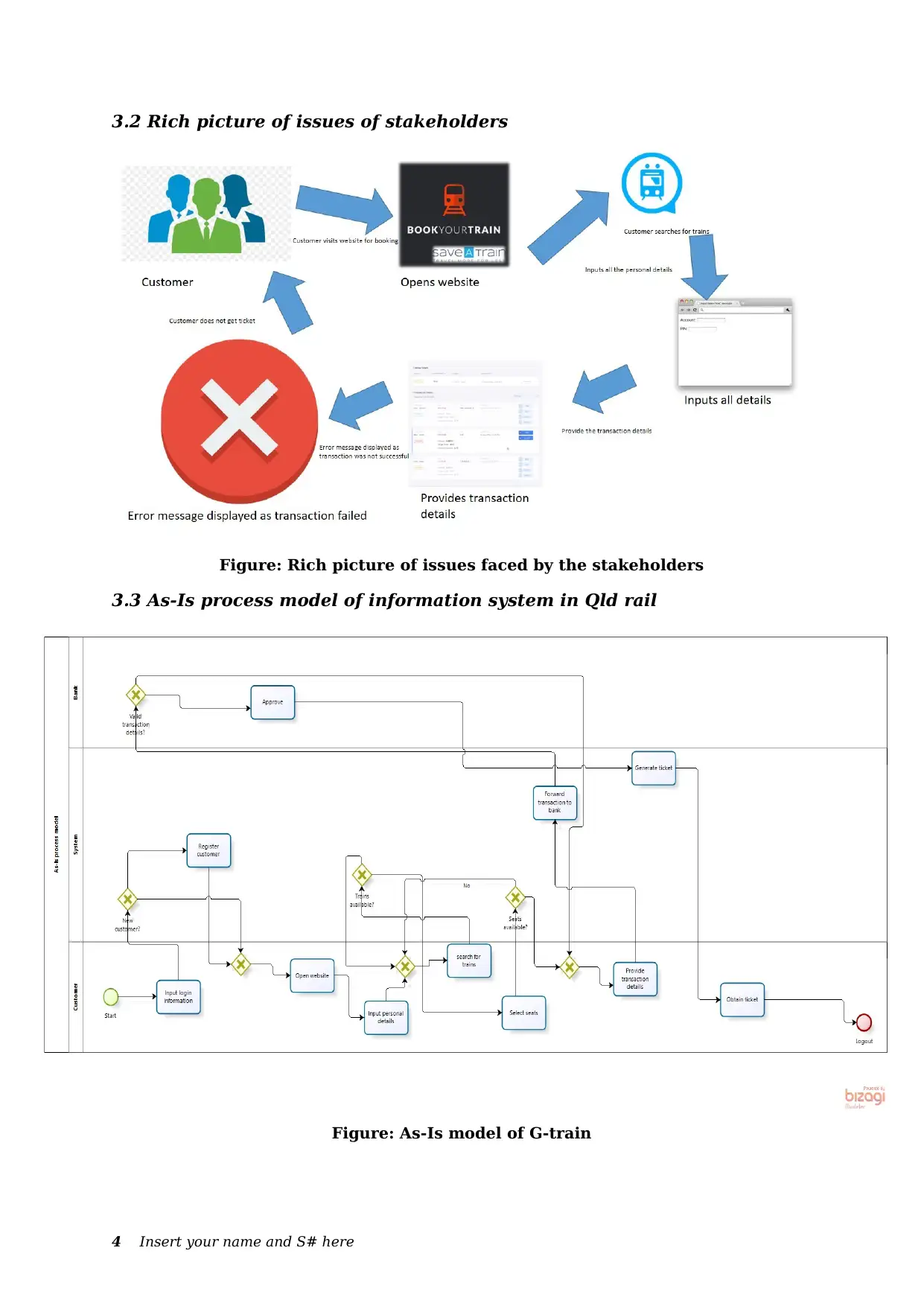
3.2 Rich picture of issues of stakeholders
Figure: Rich picture of issues faced by the stakeholders
3.3 As-Is process model of information system in Qld rail
Figure: As-Is model of G-train
4 Insert your name and S# here
Figure: Rich picture of issues faced by the stakeholders
3.3 As-Is process model of information system in Qld rail
Figure: As-Is model of G-train
4 Insert your name and S# here
Secure Best Marks with AI Grader
Need help grading? Try our AI Grader for instant feedback on your assignments.
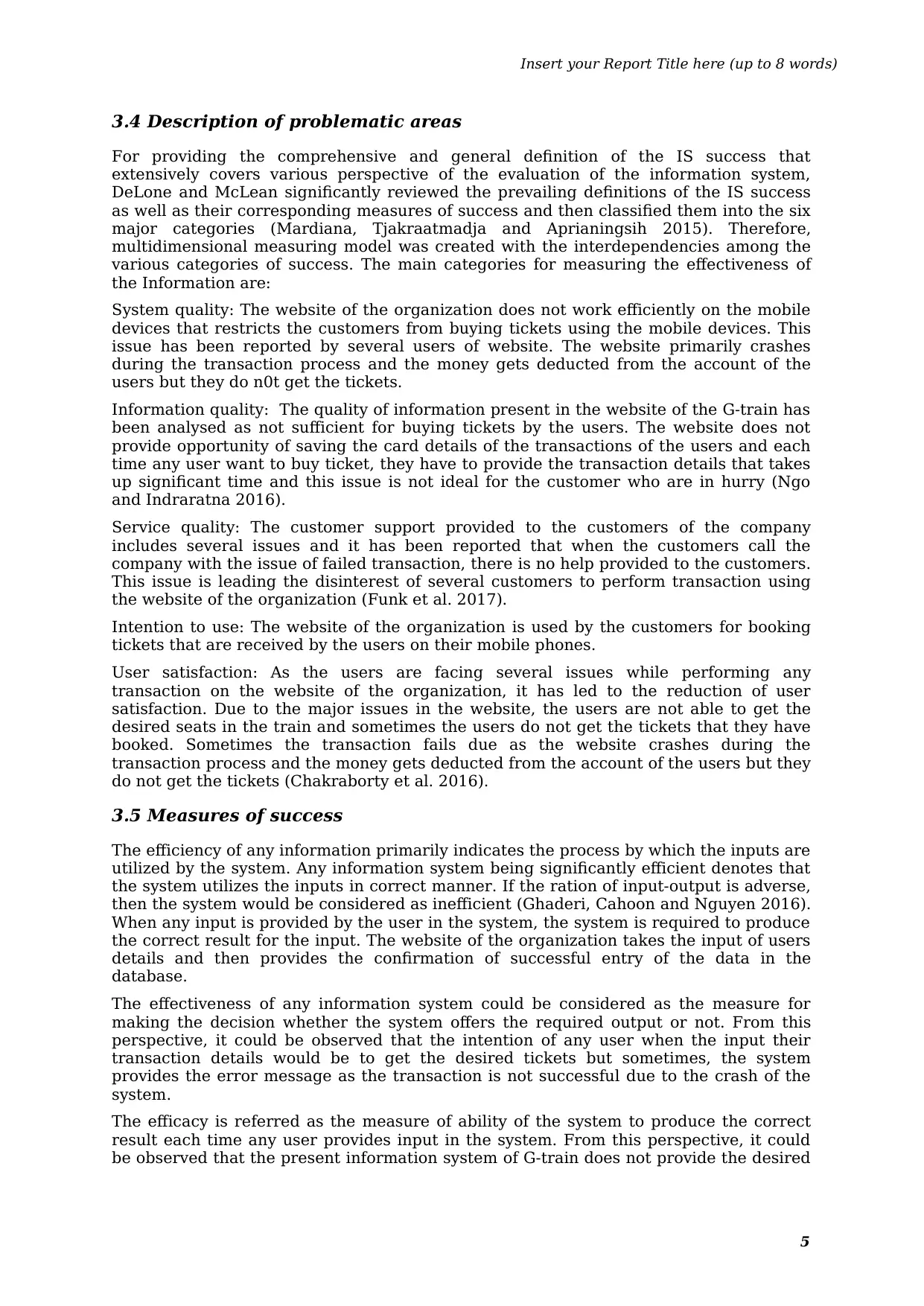
Insert your Report Title here (up to 8 words)
3.4 Description of problematic areas
For providing the comprehensive and general definition of the IS success that
extensively covers various perspective of the evaluation of the information system,
DeLone and McLean significantly reviewed the prevailing definitions of the IS success
as well as their corresponding measures of success and then classified them into the six
major categories (Mardiana, Tjakraatmadja and Aprianingsih 2015). Therefore,
multidimensional measuring model was created with the interdependencies among the
various categories of success. The main categories for measuring the effectiveness of
the Information are:
System quality: The website of the organization does not work efficiently on the mobile
devices that restricts the customers from buying tickets using the mobile devices. This
issue has been reported by several users of website. The website primarily crashes
during the transaction process and the money gets deducted from the account of the
users but they do n0t get the tickets.
Information quality: The quality of information present in the website of the G-train has
been analysed as not sufficient for buying tickets by the users. The website does not
provide opportunity of saving the card details of the transactions of the users and each
time any user want to buy ticket, they have to provide the transaction details that takes
up significant time and this issue is not ideal for the customer who are in hurry (Ngo
and Indraratna 2016).
Service quality: The customer support provided to the customers of the company
includes several issues and it has been reported that when the customers call the
company with the issue of failed transaction, there is no help provided to the customers.
This issue is leading the disinterest of several customers to perform transaction using
the website of the organization (Funk et al. 2017).
Intention to use: The website of the organization is used by the customers for booking
tickets that are received by the users on their mobile phones.
User satisfaction: As the users are facing several issues while performing any
transaction on the website of the organization, it has led to the reduction of user
satisfaction. Due to the major issues in the website, the users are not able to get the
desired seats in the train and sometimes the users do not get the tickets that they have
booked. Sometimes the transaction fails due as the website crashes during the
transaction process and the money gets deducted from the account of the users but they
do not get the tickets (Chakraborty et al. 2016).
3.5 Measures of success
The efficiency of any information primarily indicates the process by which the inputs are
utilized by the system. Any information system being significantly efficient denotes that
the system utilizes the inputs in correct manner. If the ration of input-output is adverse,
then the system would be considered as inefficient (Ghaderi, Cahoon and Nguyen 2016).
When any input is provided by the user in the system, the system is required to produce
the correct result for the input. The website of the organization takes the input of users
details and then provides the confirmation of successful entry of the data in the
database.
The effectiveness of any information system could be considered as the measure for
making the decision whether the system offers the required output or not. From this
perspective, it could be observed that the intention of any user when the input their
transaction details would be to get the desired tickets but sometimes, the system
provides the error message as the transaction is not successful due to the crash of the
system.
The efficacy is referred as the measure of ability of the system to produce the correct
result each time any user provides input in the system. From this perspective, it could
be observed that the present information system of G-train does not provide the desired
5
3.4 Description of problematic areas
For providing the comprehensive and general definition of the IS success that
extensively covers various perspective of the evaluation of the information system,
DeLone and McLean significantly reviewed the prevailing definitions of the IS success
as well as their corresponding measures of success and then classified them into the six
major categories (Mardiana, Tjakraatmadja and Aprianingsih 2015). Therefore,
multidimensional measuring model was created with the interdependencies among the
various categories of success. The main categories for measuring the effectiveness of
the Information are:
System quality: The website of the organization does not work efficiently on the mobile
devices that restricts the customers from buying tickets using the mobile devices. This
issue has been reported by several users of website. The website primarily crashes
during the transaction process and the money gets deducted from the account of the
users but they do n0t get the tickets.
Information quality: The quality of information present in the website of the G-train has
been analysed as not sufficient for buying tickets by the users. The website does not
provide opportunity of saving the card details of the transactions of the users and each
time any user want to buy ticket, they have to provide the transaction details that takes
up significant time and this issue is not ideal for the customer who are in hurry (Ngo
and Indraratna 2016).
Service quality: The customer support provided to the customers of the company
includes several issues and it has been reported that when the customers call the
company with the issue of failed transaction, there is no help provided to the customers.
This issue is leading the disinterest of several customers to perform transaction using
the website of the organization (Funk et al. 2017).
Intention to use: The website of the organization is used by the customers for booking
tickets that are received by the users on their mobile phones.
User satisfaction: As the users are facing several issues while performing any
transaction on the website of the organization, it has led to the reduction of user
satisfaction. Due to the major issues in the website, the users are not able to get the
desired seats in the train and sometimes the users do not get the tickets that they have
booked. Sometimes the transaction fails due as the website crashes during the
transaction process and the money gets deducted from the account of the users but they
do not get the tickets (Chakraborty et al. 2016).
3.5 Measures of success
The efficiency of any information primarily indicates the process by which the inputs are
utilized by the system. Any information system being significantly efficient denotes that
the system utilizes the inputs in correct manner. If the ration of input-output is adverse,
then the system would be considered as inefficient (Ghaderi, Cahoon and Nguyen 2016).
When any input is provided by the user in the system, the system is required to produce
the correct result for the input. The website of the organization takes the input of users
details and then provides the confirmation of successful entry of the data in the
database.
The effectiveness of any information system could be considered as the measure for
making the decision whether the system offers the required output or not. From this
perspective, it could be observed that the intention of any user when the input their
transaction details would be to get the desired tickets but sometimes, the system
provides the error message as the transaction is not successful due to the crash of the
system.
The efficacy is referred as the measure of ability of the system to produce the correct
result each time any user provides input in the system. From this perspective, it could
be observed that the present information system of G-train does not provide the desired
5
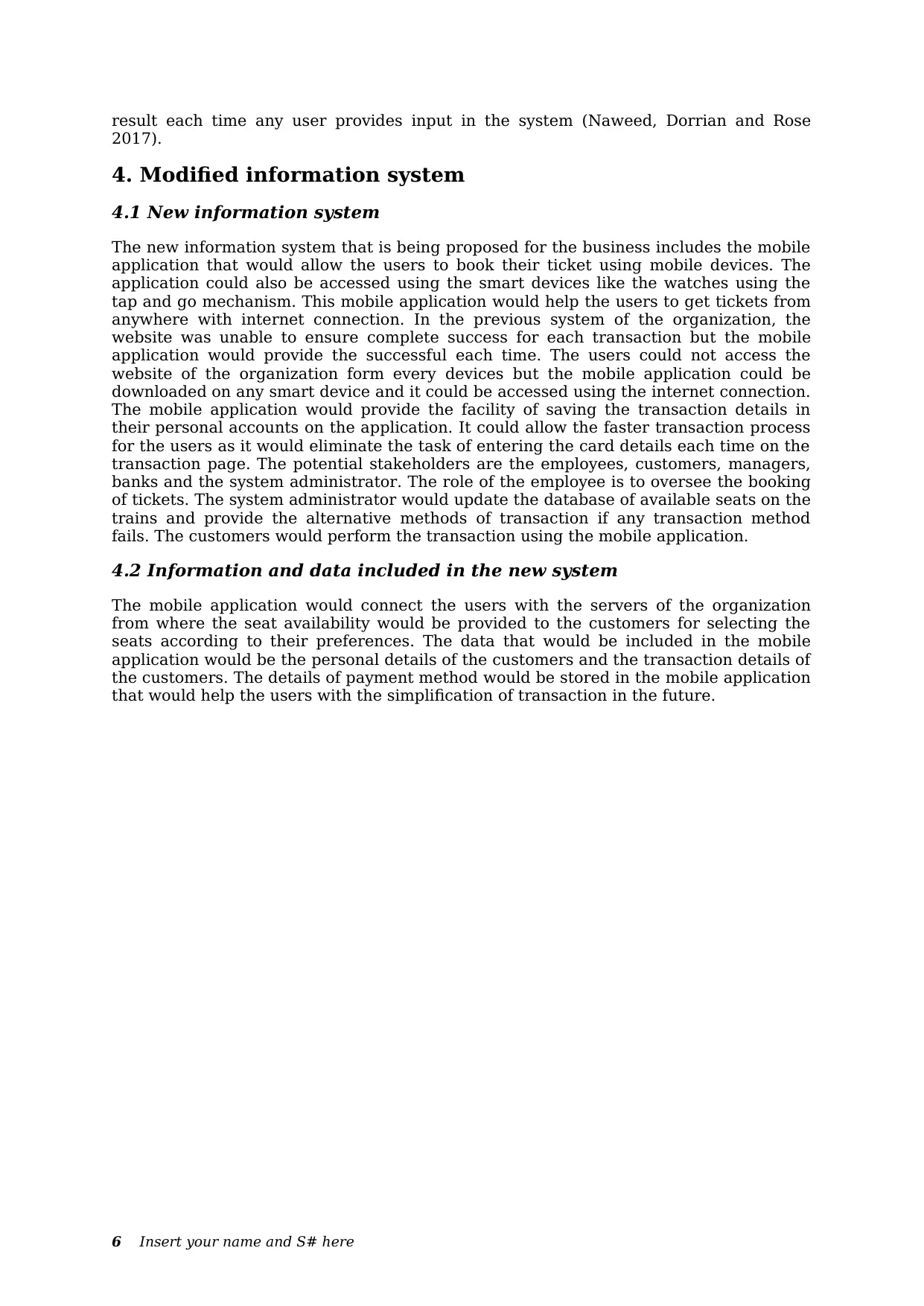
result each time any user provides input in the system (Naweed, Dorrian and Rose
2017).
4. Modified information system
4.1 New information system
The new information system that is being proposed for the business includes the mobile
application that would allow the users to book their ticket using mobile devices. The
application could also be accessed using the smart devices like the watches using the
tap and go mechanism. This mobile application would help the users to get tickets from
anywhere with internet connection. In the previous system of the organization, the
website was unable to ensure complete success for each transaction but the mobile
application would provide the successful each time. The users could not access the
website of the organization form every devices but the mobile application could be
downloaded on any smart device and it could be accessed using the internet connection.
The mobile application would provide the facility of saving the transaction details in
their personal accounts on the application. It could allow the faster transaction process
for the users as it would eliminate the task of entering the card details each time on the
transaction page. The potential stakeholders are the employees, customers, managers,
banks and the system administrator. The role of the employee is to oversee the booking
of tickets. The system administrator would update the database of available seats on the
trains and provide the alternative methods of transaction if any transaction method
fails. The customers would perform the transaction using the mobile application.
4.2 Information and data included in the new system
The mobile application would connect the users with the servers of the organization
from where the seat availability would be provided to the customers for selecting the
seats according to their preferences. The data that would be included in the mobile
application would be the personal details of the customers and the transaction details of
the customers. The details of payment method would be stored in the mobile application
that would help the users with the simplification of transaction in the future.
6 Insert your name and S# here
2017).
4. Modified information system
4.1 New information system
The new information system that is being proposed for the business includes the mobile
application that would allow the users to book their ticket using mobile devices. The
application could also be accessed using the smart devices like the watches using the
tap and go mechanism. This mobile application would help the users to get tickets from
anywhere with internet connection. In the previous system of the organization, the
website was unable to ensure complete success for each transaction but the mobile
application would provide the successful each time. The users could not access the
website of the organization form every devices but the mobile application could be
downloaded on any smart device and it could be accessed using the internet connection.
The mobile application would provide the facility of saving the transaction details in
their personal accounts on the application. It could allow the faster transaction process
for the users as it would eliminate the task of entering the card details each time on the
transaction page. The potential stakeholders are the employees, customers, managers,
banks and the system administrator. The role of the employee is to oversee the booking
of tickets. The system administrator would update the database of available seats on the
trains and provide the alternative methods of transaction if any transaction method
fails. The customers would perform the transaction using the mobile application.
4.2 Information and data included in the new system
The mobile application would connect the users with the servers of the organization
from where the seat availability would be provided to the customers for selecting the
seats according to their preferences. The data that would be included in the mobile
application would be the personal details of the customers and the transaction details of
the customers. The details of payment method would be stored in the mobile application
that would help the users with the simplification of transaction in the future.
6 Insert your name and S# here
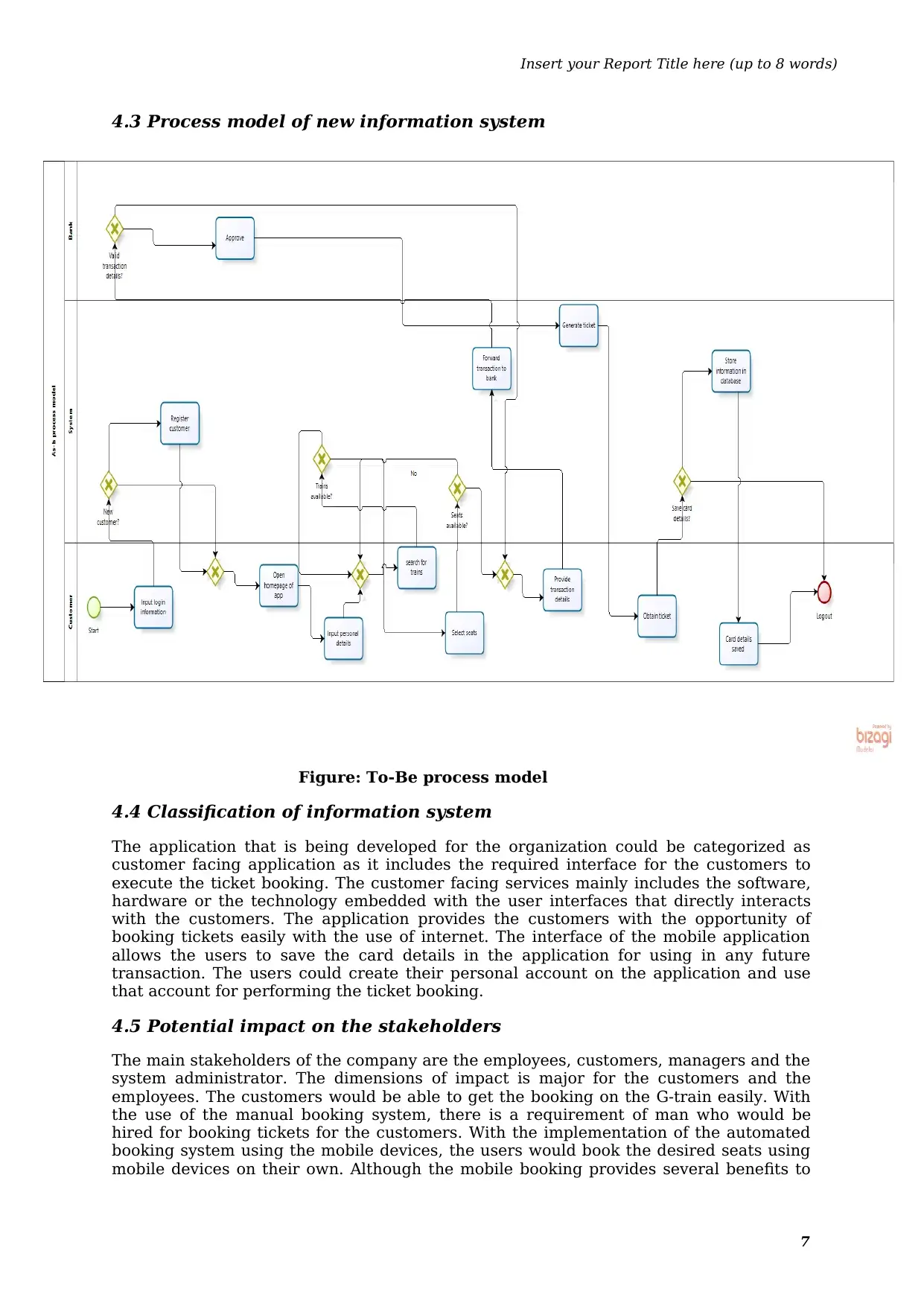
Insert your Report Title here (up to 8 words)
4.3 Process model of new information system
Figure: To-Be process model
4.4 Classification of information system
The application that is being developed for the organization could be categorized as
customer facing application as it includes the required interface for the customers to
execute the ticket booking. The customer facing services mainly includes the software,
hardware or the technology embedded with the user interfaces that directly interacts
with the customers. The application provides the customers with the opportunity of
booking tickets easily with the use of internet. The interface of the mobile application
allows the users to save the card details in the application for using in any future
transaction. The users could create their personal account on the application and use
that account for performing the ticket booking.
4.5 Potential impact on the stakeholders
The main stakeholders of the company are the employees, customers, managers and the
system administrator. The dimensions of impact is major for the customers and the
employees. The customers would be able to get the booking on the G-train easily. With
the use of the manual booking system, there is a requirement of man who would be
hired for booking tickets for the customers. With the implementation of the automated
booking system using the mobile devices, the users would book the desired seats using
mobile devices on their own. Although the mobile booking provides several benefits to
7
4.3 Process model of new information system
Figure: To-Be process model
4.4 Classification of information system
The application that is being developed for the organization could be categorized as
customer facing application as it includes the required interface for the customers to
execute the ticket booking. The customer facing services mainly includes the software,
hardware or the technology embedded with the user interfaces that directly interacts
with the customers. The application provides the customers with the opportunity of
booking tickets easily with the use of internet. The interface of the mobile application
allows the users to save the card details in the application for using in any future
transaction. The users could create their personal account on the application and use
that account for performing the ticket booking.
4.5 Potential impact on the stakeholders
The main stakeholders of the company are the employees, customers, managers and the
system administrator. The dimensions of impact is major for the customers and the
employees. The customers would be able to get the booking on the G-train easily. With
the use of the manual booking system, there is a requirement of man who would be
hired for booking tickets for the customers. With the implementation of the automated
booking system using the mobile devices, the users would book the desired seats using
mobile devices on their own. Although the mobile booking provides several benefits to
7
Paraphrase This Document
Need a fresh take? Get an instant paraphrase of this document with our AI Paraphraser
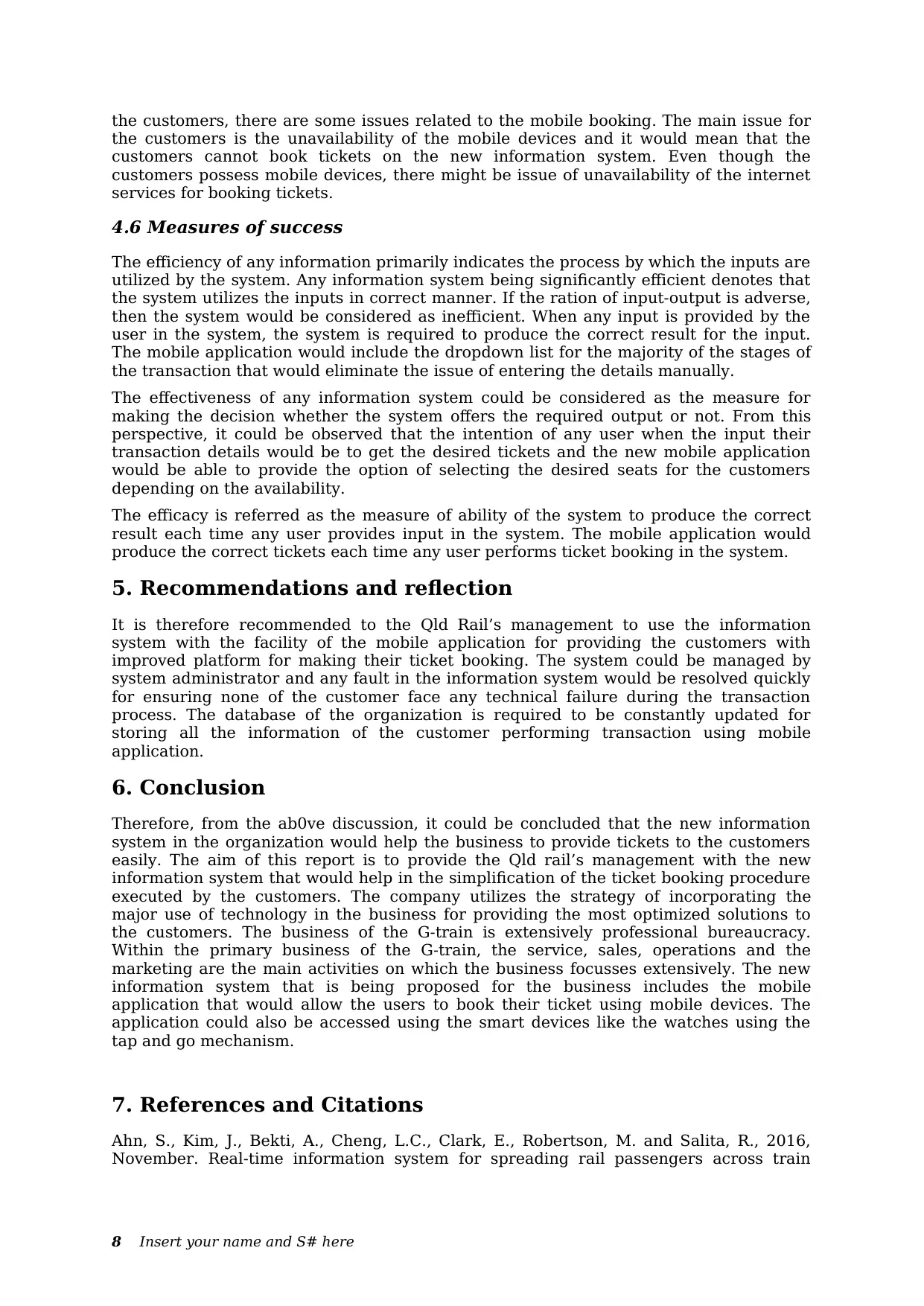
the customers, there are some issues related to the mobile booking. The main issue for
the customers is the unavailability of the mobile devices and it would mean that the
customers cannot book tickets on the new information system. Even though the
customers possess mobile devices, there might be issue of unavailability of the internet
services for booking tickets.
4.6 Measures of success
The efficiency of any information primarily indicates the process by which the inputs are
utilized by the system. Any information system being significantly efficient denotes that
the system utilizes the inputs in correct manner. If the ration of input-output is adverse,
then the system would be considered as inefficient. When any input is provided by the
user in the system, the system is required to produce the correct result for the input.
The mobile application would include the dropdown list for the majority of the stages of
the transaction that would eliminate the issue of entering the details manually.
The effectiveness of any information system could be considered as the measure for
making the decision whether the system offers the required output or not. From this
perspective, it could be observed that the intention of any user when the input their
transaction details would be to get the desired tickets and the new mobile application
would be able to provide the option of selecting the desired seats for the customers
depending on the availability.
The efficacy is referred as the measure of ability of the system to produce the correct
result each time any user provides input in the system. The mobile application would
produce the correct tickets each time any user performs ticket booking in the system.
5. Recommendations and reflection
It is therefore recommended to the Qld Rail’s management to use the information
system with the facility of the mobile application for providing the customers with
improved platform for making their ticket booking. The system could be managed by
system administrator and any fault in the information system would be resolved quickly
for ensuring none of the customer face any technical failure during the transaction
process. The database of the organization is required to be constantly updated for
storing all the information of the customer performing transaction using mobile
application.
6. Conclusion
Therefore, from the ab0ve discussion, it could be concluded that the new information
system in the organization would help the business to provide tickets to the customers
easily. The aim of this report is to provide the Qld rail’s management with the new
information system that would help in the simplification of the ticket booking procedure
executed by the customers. The company utilizes the strategy of incorporating the
major use of technology in the business for providing the most optimized solutions to
the customers. The business of the G-train is extensively professional bureaucracy.
Within the primary business of the G-train, the service, sales, operations and the
marketing are the main activities on which the business focusses extensively. The new
information system that is being proposed for the business includes the mobile
application that would allow the users to book their ticket using mobile devices. The
application could also be accessed using the smart devices like the watches using the
tap and go mechanism.
7. References and Citations
Ahn, S., Kim, J., Bekti, A., Cheng, L.C., Clark, E., Robertson, M. and Salita, R., 2016,
November. Real-time information system for spreading rail passengers across train
8 Insert your name and S# here
the customers is the unavailability of the mobile devices and it would mean that the
customers cannot book tickets on the new information system. Even though the
customers possess mobile devices, there might be issue of unavailability of the internet
services for booking tickets.
4.6 Measures of success
The efficiency of any information primarily indicates the process by which the inputs are
utilized by the system. Any information system being significantly efficient denotes that
the system utilizes the inputs in correct manner. If the ration of input-output is adverse,
then the system would be considered as inefficient. When any input is provided by the
user in the system, the system is required to produce the correct result for the input.
The mobile application would include the dropdown list for the majority of the stages of
the transaction that would eliminate the issue of entering the details manually.
The effectiveness of any information system could be considered as the measure for
making the decision whether the system offers the required output or not. From this
perspective, it could be observed that the intention of any user when the input their
transaction details would be to get the desired tickets and the new mobile application
would be able to provide the option of selecting the desired seats for the customers
depending on the availability.
The efficacy is referred as the measure of ability of the system to produce the correct
result each time any user provides input in the system. The mobile application would
produce the correct tickets each time any user performs ticket booking in the system.
5. Recommendations and reflection
It is therefore recommended to the Qld Rail’s management to use the information
system with the facility of the mobile application for providing the customers with
improved platform for making their ticket booking. The system could be managed by
system administrator and any fault in the information system would be resolved quickly
for ensuring none of the customer face any technical failure during the transaction
process. The database of the organization is required to be constantly updated for
storing all the information of the customer performing transaction using mobile
application.
6. Conclusion
Therefore, from the ab0ve discussion, it could be concluded that the new information
system in the organization would help the business to provide tickets to the customers
easily. The aim of this report is to provide the Qld rail’s management with the new
information system that would help in the simplification of the ticket booking procedure
executed by the customers. The company utilizes the strategy of incorporating the
major use of technology in the business for providing the most optimized solutions to
the customers. The business of the G-train is extensively professional bureaucracy.
Within the primary business of the G-train, the service, sales, operations and the
marketing are the main activities on which the business focusses extensively. The new
information system that is being proposed for the business includes the mobile
application that would allow the users to book their ticket using mobile devices. The
application could also be accessed using the smart devices like the watches using the
tap and go mechanism.
7. References and Citations
Ahn, S., Kim, J., Bekti, A., Cheng, L.C., Clark, E., Robertson, M. and Salita, R., 2016,
November. Real-time information system for spreading rail passengers across train
8 Insert your name and S# here
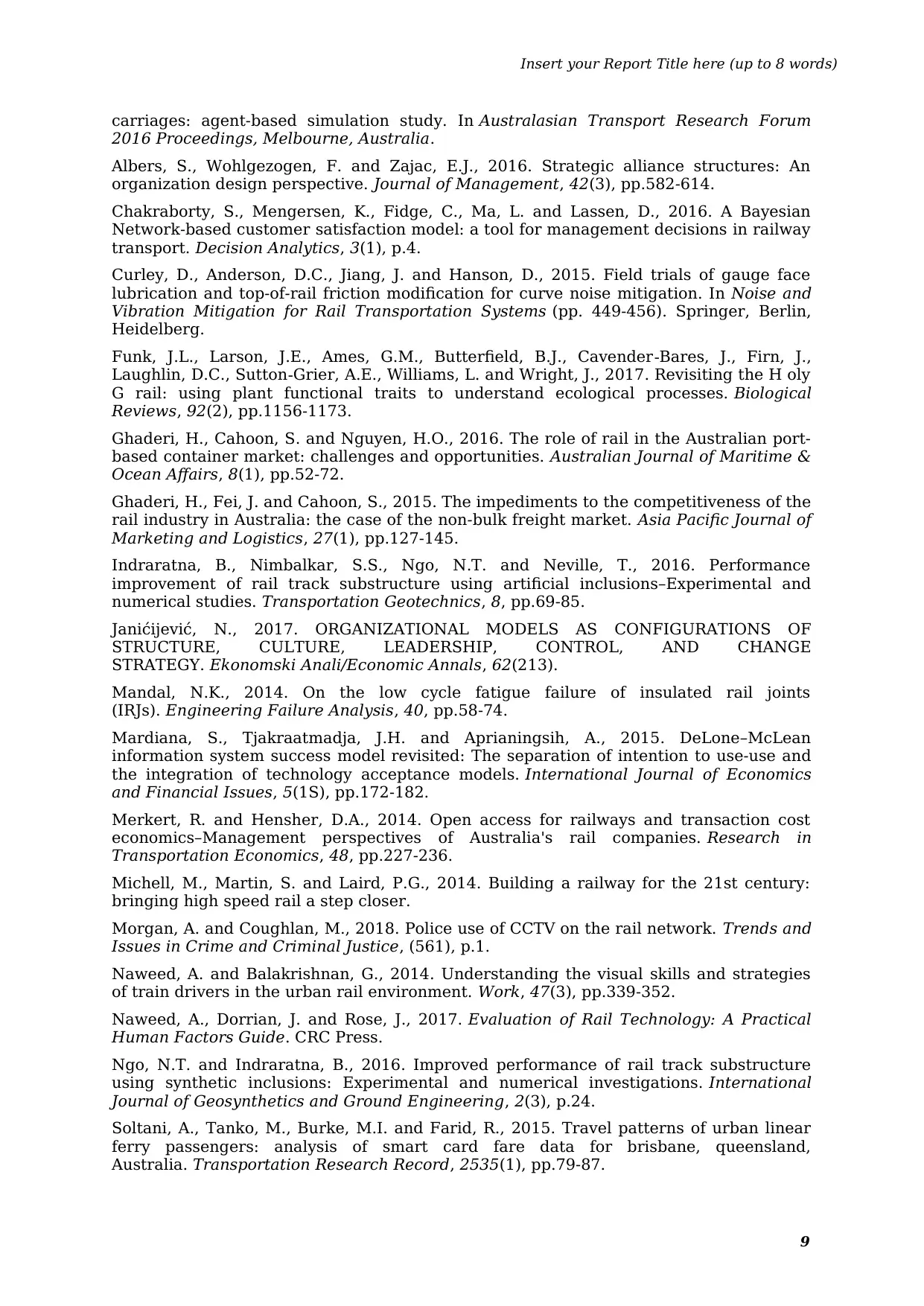
Insert your Report Title here (up to 8 words)
carriages: agent-based simulation study. In Australasian Transport Research Forum
2016 Proceedings, Melbourne, Australia.
Albers, S., Wohlgezogen, F. and Zajac, E.J., 2016. Strategic alliance structures: An
organization design perspective. Journal of Management, 42(3), pp.582-614.
Chakraborty, S., Mengersen, K., Fidge, C., Ma, L. and Lassen, D., 2016. A Bayesian
Network-based customer satisfaction model: a tool for management decisions in railway
transport. Decision Analytics, 3(1), p.4.
Curley, D., Anderson, D.C., Jiang, J. and Hanson, D., 2015. Field trials of gauge face
lubrication and top-of-rail friction modification for curve noise mitigation. In Noise and
Vibration Mitigation for Rail Transportation Systems (pp. 449-456). Springer, Berlin,
Heidelberg.
Funk, J.L., Larson, J.E., Ames, G.M., Butterfield, B.J., Cavender‐Bares, J., Firn, J.,
Laughlin, D.C., Sutton‐Grier, A.E., Williams, L. and Wright, J., 2017. Revisiting the H oly
G rail: using plant functional traits to understand ecological processes. Biological
Reviews, 92(2), pp.1156-1173.
Ghaderi, H., Cahoon, S. and Nguyen, H.O., 2016. The role of rail in the Australian port-
based container market: challenges and opportunities. Australian Journal of Maritime &
Ocean Affairs, 8(1), pp.52-72.
Ghaderi, H., Fei, J. and Cahoon, S., 2015. The impediments to the competitiveness of the
rail industry in Australia: the case of the non-bulk freight market. Asia Pacific Journal of
Marketing and Logistics, 27(1), pp.127-145.
Indraratna, B., Nimbalkar, S.S., Ngo, N.T. and Neville, T., 2016. Performance
improvement of rail track substructure using artificial inclusions–Experimental and
numerical studies. Transportation Geotechnics, 8, pp.69-85.
Janićijević, N., 2017. ORGANIZATIONAL MODELS AS CONFIGURATIONS OF
STRUCTURE, CULTURE, LEADERSHIP, CONTROL, AND CHANGE
STRATEGY. Ekonomski Anali/Economic Annals, 62(213).
Mandal, N.K., 2014. On the low cycle fatigue failure of insulated rail joints
(IRJs). Engineering Failure Analysis, 40, pp.58-74.
Mardiana, S., Tjakraatmadja, J.H. and Aprianingsih, A., 2015. DeLone–McLean
information system success model revisited: The separation of intention to use-use and
the integration of technology acceptance models. International Journal of Economics
and Financial Issues, 5(1S), pp.172-182.
Merkert, R. and Hensher, D.A., 2014. Open access for railways and transaction cost
economics–Management perspectives of Australia's rail companies. Research in
Transportation Economics, 48, pp.227-236.
Michell, M., Martin, S. and Laird, P.G., 2014. Building a railway for the 21st century:
bringing high speed rail a step closer.
Morgan, A. and Coughlan, M., 2018. Police use of CCTV on the rail network. Trends and
Issues in Crime and Criminal Justice, (561), p.1.
Naweed, A. and Balakrishnan, G., 2014. Understanding the visual skills and strategies
of train drivers in the urban rail environment. Work, 47(3), pp.339-352.
Naweed, A., Dorrian, J. and Rose, J., 2017. Evaluation of Rail Technology: A Practical
Human Factors Guide. CRC Press.
Ngo, N.T. and Indraratna, B., 2016. Improved performance of rail track substructure
using synthetic inclusions: Experimental and numerical investigations. International
Journal of Geosynthetics and Ground Engineering, 2(3), p.24.
Soltani, A., Tanko, M., Burke, M.I. and Farid, R., 2015. Travel patterns of urban linear
ferry passengers: analysis of smart card fare data for brisbane, queensland,
Australia. Transportation Research Record, 2535(1), pp.79-87.
9
carriages: agent-based simulation study. In Australasian Transport Research Forum
2016 Proceedings, Melbourne, Australia.
Albers, S., Wohlgezogen, F. and Zajac, E.J., 2016. Strategic alliance structures: An
organization design perspective. Journal of Management, 42(3), pp.582-614.
Chakraborty, S., Mengersen, K., Fidge, C., Ma, L. and Lassen, D., 2016. A Bayesian
Network-based customer satisfaction model: a tool for management decisions in railway
transport. Decision Analytics, 3(1), p.4.
Curley, D., Anderson, D.C., Jiang, J. and Hanson, D., 2015. Field trials of gauge face
lubrication and top-of-rail friction modification for curve noise mitigation. In Noise and
Vibration Mitigation for Rail Transportation Systems (pp. 449-456). Springer, Berlin,
Heidelberg.
Funk, J.L., Larson, J.E., Ames, G.M., Butterfield, B.J., Cavender‐Bares, J., Firn, J.,
Laughlin, D.C., Sutton‐Grier, A.E., Williams, L. and Wright, J., 2017. Revisiting the H oly
G rail: using plant functional traits to understand ecological processes. Biological
Reviews, 92(2), pp.1156-1173.
Ghaderi, H., Cahoon, S. and Nguyen, H.O., 2016. The role of rail in the Australian port-
based container market: challenges and opportunities. Australian Journal of Maritime &
Ocean Affairs, 8(1), pp.52-72.
Ghaderi, H., Fei, J. and Cahoon, S., 2015. The impediments to the competitiveness of the
rail industry in Australia: the case of the non-bulk freight market. Asia Pacific Journal of
Marketing and Logistics, 27(1), pp.127-145.
Indraratna, B., Nimbalkar, S.S., Ngo, N.T. and Neville, T., 2016. Performance
improvement of rail track substructure using artificial inclusions–Experimental and
numerical studies. Transportation Geotechnics, 8, pp.69-85.
Janićijević, N., 2017. ORGANIZATIONAL MODELS AS CONFIGURATIONS OF
STRUCTURE, CULTURE, LEADERSHIP, CONTROL, AND CHANGE
STRATEGY. Ekonomski Anali/Economic Annals, 62(213).
Mandal, N.K., 2014. On the low cycle fatigue failure of insulated rail joints
(IRJs). Engineering Failure Analysis, 40, pp.58-74.
Mardiana, S., Tjakraatmadja, J.H. and Aprianingsih, A., 2015. DeLone–McLean
information system success model revisited: The separation of intention to use-use and
the integration of technology acceptance models. International Journal of Economics
and Financial Issues, 5(1S), pp.172-182.
Merkert, R. and Hensher, D.A., 2014. Open access for railways and transaction cost
economics–Management perspectives of Australia's rail companies. Research in
Transportation Economics, 48, pp.227-236.
Michell, M., Martin, S. and Laird, P.G., 2014. Building a railway for the 21st century:
bringing high speed rail a step closer.
Morgan, A. and Coughlan, M., 2018. Police use of CCTV on the rail network. Trends and
Issues in Crime and Criminal Justice, (561), p.1.
Naweed, A. and Balakrishnan, G., 2014. Understanding the visual skills and strategies
of train drivers in the urban rail environment. Work, 47(3), pp.339-352.
Naweed, A., Dorrian, J. and Rose, J., 2017. Evaluation of Rail Technology: A Practical
Human Factors Guide. CRC Press.
Ngo, N.T. and Indraratna, B., 2016. Improved performance of rail track substructure
using synthetic inclusions: Experimental and numerical investigations. International
Journal of Geosynthetics and Ground Engineering, 2(3), p.24.
Soltani, A., Tanko, M., Burke, M.I. and Farid, R., 2015. Travel patterns of urban linear
ferry passengers: analysis of smart card fare data for brisbane, queensland,
Australia. Transportation Research Record, 2535(1), pp.79-87.
9
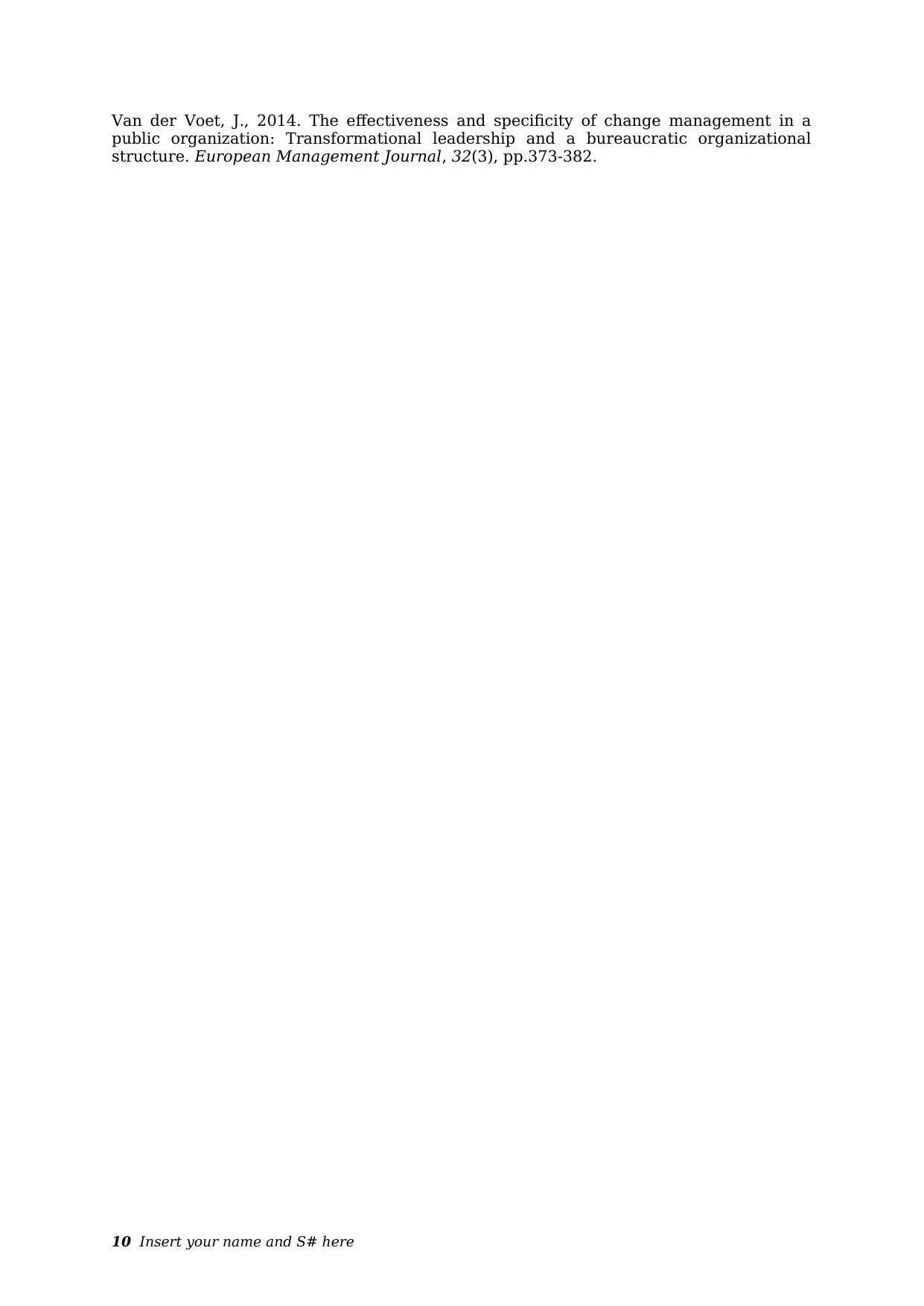
Van der Voet, J., 2014. The effectiveness and specificity of change management in a
public organization: Transformational leadership and a bureaucratic organizational
structure. European Management Journal, 32(3), pp.373-382.
10 Insert your name and S# here
public organization: Transformational leadership and a bureaucratic organizational
structure. European Management Journal, 32(3), pp.373-382.
10 Insert your name and S# here
1 out of 10
Related Documents
Your All-in-One AI-Powered Toolkit for Academic Success.
+13062052269
info@desklib.com
Available 24*7 on WhatsApp / Email
![[object Object]](/_next/static/media/star-bottom.7253800d.svg)
Unlock your academic potential
© 2024 | Zucol Services PVT LTD | All rights reserved.





